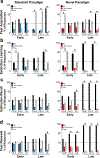Comparison of behavioral and brain indices of fear renewal during a standard vs. novel immersive reality Pavlovian fear extinction paradigm in healthy adults
- PMID: 36244544
- PMCID: PMC10277015
- DOI: 10.1016/j.bbr.2022.114154
Comparison of behavioral and brain indices of fear renewal during a standard vs. novel immersive reality Pavlovian fear extinction paradigm in healthy adults
Abstract
Pavlovian conditioning paradigms model the learned fear associations inherent in posttraumatic stress disorder, including the renewal of inappropriate fear responses following extinction learning. However, very few studies in humans investigate the underlying neural mechanisms involved in fear renewal despite its clinical importance. To address this issue, our lab designed a novel, immersive-reality Pavlovian fear acquisition, extinction, recall, and renewal paradigm. We utilized an ecological threat - a snake striking towards the participant - as the unconditioned stimulus (US). Context and background were dynamic and included both visual and auditory cues that are relevant to everyday life. Using functional magnetic resonance imaging and behavioral measures (US expectancy ratings), we examined the validity of this Novel paradigm in healthy adults (n = 49) and compared it to a Standard, well-validated 2D paradigm (n = 28). The Novel paradigm, compared to the Standard, was associated with greater hippocampal activation throughout the task. Participants who underwent the Standard paradigm, compared to the Novel, also displayed insula activation; however, this was not specific to stimulus or time. During fear renewal, the Novel paradigm was associated with dorsal anterior cingulate cortex activation to CS+ (> CS-). Overall, we found that our Novel, immersive-reality paradigm, which features an ecologically relevant US, elicited greater corticolimbic activation. These results suggest that immersive Pavlovian fear conditioning paradigms paired with innately fearful stimuli may improve translatability of preclinical paradigms to clinical interventions for fear-based disorders.
Keywords: Amygdala; FMRI; Fear renewal; Hippocampus; Prefrontal cortex; Virtual reality.
Copyright © 2022 Elsevier B.V. All rights reserved.
Figures




Similar articles
-
Medial prefrontal pathways for the contextual regulation of extinguished fear in humans.Neuroimage. 2015 Nov 15;122:262-71. doi: 10.1016/j.neuroimage.2015.07.051. Epub 2015 Jul 26. Neuroimage. 2015. PMID: 26220745 Free PMC article.
-
Neural circuitry underlying effects of context on human pain-related fear extinction in a renewal paradigm.Hum Brain Mapp. 2015 Aug;36(8):3179-93. doi: 10.1002/hbm.22837. Epub 2015 Jun 9. Hum Brain Mapp. 2015. PMID: 26058893 Free PMC article.
-
Poor between-session recall of extinction learning and hippocampal activation and connectivity in children.Neurobiol Learn Mem. 2018 Dec;156:86-95. doi: 10.1016/j.nlm.2018.10.007. Epub 2018 Oct 19. Neurobiol Learn Mem. 2018. PMID: 30347237 Free PMC article.
-
BEHAVIORAL AND NEUROBIOLOGICAL MECHANISMS OF PAVLOVIAN AND INSTRUMENTAL EXTINCTION LEARNING.Physiol Rev. 2021 Apr 1;101(2):611-681. doi: 10.1152/physrev.00016.2020. Epub 2020 Sep 24. Physiol Rev. 2021. PMID: 32970967 Free PMC article. Review.
-
Revisiting potential associations between brain morphology, fear acquisition and extinction through new data and a literature review.Sci Rep. 2020 Nov 16;10(1):19894. doi: 10.1038/s41598-020-76683-1. Sci Rep. 2020. PMID: 33199738 Free PMC article. Review.
Cited by
-
Understanding Human Fear Extinction: Insights from Psychophysiology.Curr Top Behav Neurosci. 2023;64:59-77. doi: 10.1007/7854_2023_435. Curr Top Behav Neurosci. 2023. PMID: 37528308
-
Voluntary alcohol consumption during distinct phases of adolescence differentially alters adult fear acquisition, extinction and renewal in male and female rats.Stress. 2023 Nov;26(1):2278315. doi: 10.1080/10253890.2023.2278315. Epub 2023 Nov 5. Stress. 2023. PMID: 37916300 Free PMC article.
-
The Role of Serotonin in Fear Learning and Memory: A Systematic Review of Human Studies.Brain Sci. 2023 Aug 12;13(8):1197. doi: 10.3390/brainsci13081197. Brain Sci. 2023. PMID: 37626553 Free PMC article. Review.
-
Neuroimaging of Fear Extinction.Curr Top Behav Neurosci. 2023;64:79-101. doi: 10.1007/7854_2023_429. Curr Top Behav Neurosci. 2023. PMID: 37455302 Review.
-
Voluntary alcohol consumption during distinct phases of adolescence differentially alters adult fear acquisition, extinction and renewal in male and female rats.bioRxiv [Preprint]. 2023 Oct 5:2023.10.03.560757. doi: 10.1101/2023.10.03.560757. bioRxiv. 2023. Update in: Stress. 2023 Nov;26(1):2278315. doi: 10.1080/10253890.2023.2278315. PMID: 37873067 Free PMC article. Updated. Preprint.
References
Publication types
MeSH terms
Grants and funding
LinkOut - more resources
Full Text Sources
Miscellaneous

